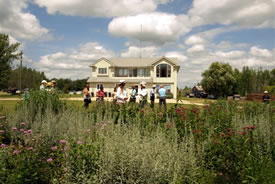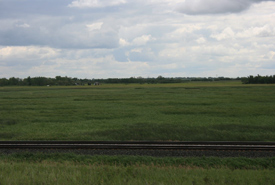Visit us!
One of the the best ways to appreciate the work of the Nature Conservancy of Canada (NCC) is to visit some of our spectacular properties. NCC in Manitoba encourages you to connect with the things that bring you joy in life. And we know just the places for you to do this.
Guidelines for visiting NCC properties
When visiting our properties, please:
- respect wildlife and other visitors
- remove your garbage
- travel on designated paths
- ensure dogs are accompanied by their owner and on a leash
- refrain from lighting fires or smoking
- do not remove plants or wildlife
Disclaimer: all visitors to NCC properties do so at their own risk.
The Weston Family Tallgrass Prairie Interpretive Centre

The Weston Family Tall Grass Prairie Interpretive Centre, MB (Photo by Mike Dembeck)
Located in the heart of the Manitoba Tall Grass Prairie Preserve, NCC's The Weston Family Tallgrass Interpretive Centre (a redesigned 3,000-square-foot home) is located on a 65-hectare site showcasing the beauty and diversity of the rare ecosystem around it.
The centre includes interactive displays and exhibits, a 37-square-metre prairie mural, a meeting space and an observation deck on the second floor. The surrounding grounds feature a prairie garden, picnic shelter and the Prairie Orchid hiking trail.
Located 100 kilometres southeast of Winnipeg, near the community of Stuartburn, the centre is open year round for school, youth and community group programming and is also available for rental for private events and meetings.
Visitors can enjoy presentations and tour one of the most endangered ecosystems in North America: the tall grass prairie.
The Agassiz Interpretive Trail

Prairie Day event, Manitoba (Photo by NCC)
Located next to The Weston Tallgrass Prairie Interpretive Centre, the Agassiz Interpretive Trail is an incredible example of the tall grass prairie ecosystem. It is the meeting place for many diverse communities of wildlife and plants. Visitors to this endangered habitat will leave with a true sense of why this ecosystem is worth protecting and how NCC is working hard to secure these precious lands for our children and grandchildren.
The Agassiz Interpretive Trail features two hiking options:
- the longer, 3.2-kilometre trail takes you around the 130-hectare site.
- the shorter loop, almost two kilometres, weaves through 54 hectares.
The trail features several rest stops, two picnic areas (one at the trailhead and one at the halfway point) and washrooms at the trailhead. The trailhead and parking area are situated on the east side of the property.
The trail has been groomed to enable people of all ages, including researchers and school-age children whose studies include Manitoba's natural history, to walk among 500 species of plants and animals, including rare and endangered species that are found within their natural habitat.
To reach the Agassiz Interpretive Trail from Highway 59, travel 11.5 kilometres east on Highway 201 and watch for the trail signs.
The Forks Prairie Garden

The Forks Prairie Garden, Manitoba (Photo by NCC)
Just a stone's throw from the heart of the city of Winnipeg, at the junction of the Red and Assiniboine rivers, lies The Forks Prairie Garden project.
In 1999, NCC partnered with the Forks Renewal Corporation and others to establish a demonstration garden that featured Manitoba's natural heritage, in anticipation of it being a showcase for visitors at the Pan Am Games. The project became so significant in its impact that it became a permanent feature at The Forks. Now, over 15 years later, the 1,858-square-metre garden features various native tall grass prairie grasses and wildflowers, providing visitors with a glimpse into Manitoba's natural history.
This project has become NCC's most frequently visited project in Manitoba, with an estimated four million visitors passing through each year.
Only a low stone wall separates beds of bergamot, gaillardia and harebell from the steady flow of passing motorists, pedestrians and cyclists. Along one side of the carefully tended plots of native wildflowers and grasses, diners satisfy their appetites on lush salads, burgers and fresh pasta.
The scene is a far cry from the wilderness that once covered this bustling downtown crossroads. Centuries before the city arose on the riverbanks, The Forks was a meeting place for Indigenous Peoples.
In the fall of 2017, The Forks Prairie Garden received some upgrades. NCC received generous support from The Winnipeg Foundation to implement capital improvements to The Forks Prairie Garden. These included:
• an entrance sign;
• new walkway and small gathering area; and
• large interpretive sign.
Further upgrades to the site will continue with interpretive signs and a larger gathering area in the plan, pending funding. In the meantime, make sure to check out The Forks Prairie Garden throughout the seasons to experience how the garden changes. While you’re there make sure to take a picture and tag NCC in it throughout your social media (@NCC_CNC). We would love to see you enjoying the space!
NCC would like to extend our gratitude to The Winnipeg Foundation for their generous support.
The Forks Prairie Garden, supported by NCC and several other conservation partners, is a reminder of modern Winnipeg's prairie roots.
Fort Ellice

Gaillardia flowers, Fort Ellice, MB (Photo by Karol Dabbs)
NCC attained a true treasure in May 2012 with the purchase of Fort Ellice: a 1,416-hectare property. Fort Ellice is a significant historical and natural site. Sandhill prairie, oak-aspen forest, mixed-grass prairie and aspen parkland exist in this unique landscape. The area supports more than 160 species at risk and NCC continues to protect these habitats.
Directions:
- NCC's Fort Ellice property is located on the west side of St. Lazare.
- Exit the town through Highway 41 and drive approximately one mile.
- There will be a a right-hand turn south onto a gravel road. Follow that road to Fort Ellice.
- Fort Ellice is positioned on Beaver Creek, near the confluence of the Assiniboine and Qu'Appelle Rivers, just east of the present-day Manitoba-Saskatchewan border.
Before heading out to Fort Ellice, please contact the Manitoba Region at 1-877-231-3552 to obtain prior permission and to coordinate your visit.
Stony Mountain Prairie Preserve

Large yellow lady's-slipper, MB (Photo by NCC)
The Stony Mountain Prairie Preserve is located on the top of the Stony Mountain escarpment. It features a unique oasis of grasses and flowers common to the native tallgrass and mixed-grass prairies that once covered the region. Just a 20-minute drive north of Winnipeg, within the town of Stony Mountain, this unique site is situated on limestone bedrock and features a valuable remnant of native prairie.
Visitors to the preserve can explore a five-kilometre recreational trail network that pass by naturally reclaimed quarries and a wide variety of amazing prairie flora.
Douglas Marsh

Douglas Marsh (Photo by NCC)
The Douglas Marsh project is located 25 kilometres east of Brandon and includes a portion of the largest wetland system in the Assiniboine Delta aquifer. This project includes a diverse set of habitats, including sedge meadows, cattail marshes, shrubby fens and adjacent mixed-grass prairie. It is a designated Important Bird Area that provides globally significant habitat for yellow rail, an at-risk bird species in Manitoba.
In partnership with NCC, the Central Assiniboine Watershed District opened an interpretive site on this property in 2022, with support from the Conservation Trust. The site features a variety of beautiful interpretive signs that tell the story of this amazing place.
You'll find the interpretive site just off Provincial Rd 340, two minutes south of Douglas, Manitoba.




